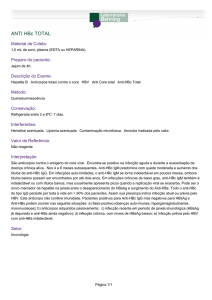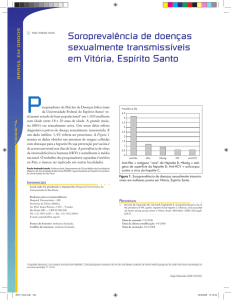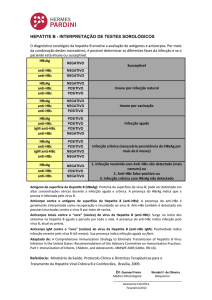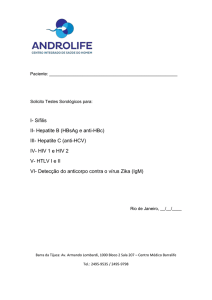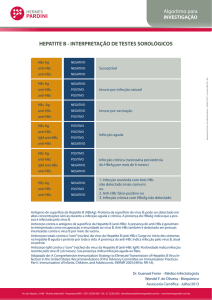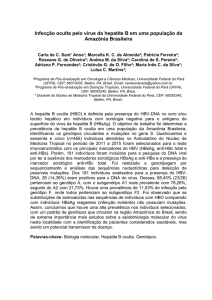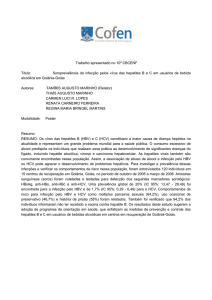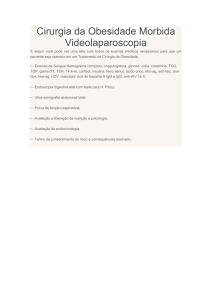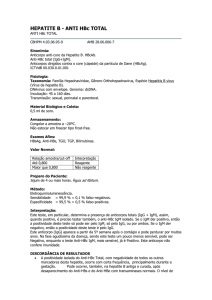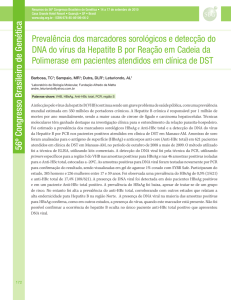06ModII-JMPereira-Diagnostico Lab Infecçoes HBV HCV
Propaganda
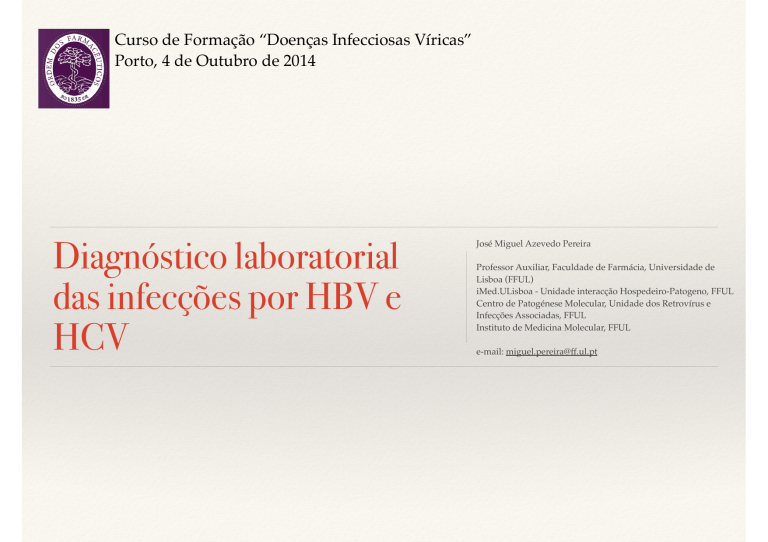
Curso de Formação “Doenças Infecciosas Víricas”! Porto, 4 de Outubro de 2014 Diagnóstico laboratorial das infecções por HBV e HCV José Miguel Azevedo Pereira! ! Professor Auxiliar, Faculdade de Farmácia, Universidade de Lisboa (FFUL)! iMed.ULisboa - Unidade interacção Hospedeiro-Patogeno, FFUL ! Centro de Patogénese Molecular, Unidade dos Retrovírus e Infecções Associadas, FFUL! Instituto de Medicina Molecular, FFUL! ! e-mail: [email protected] HBV e HCV como graves problemas de saúde pública ❖ 500 milhões de indivíduos com hepatite crónica de origem viral! ❖ Mais de 1,5 milhões morrem anualmente de doença hepática causada pelo HBV e HCV: cirrose descompensada e carcinoma hepato-celular J.M. Azevedo Pereira FFUL HBV - várias infecções distintas ❖ Infecção primária - assintomática ou sub-clínica! ❖ Infecção primária - hepatite aguda! ❖ Infecção primária - hepatite fulminante! ❖ Infecção persistente - sub-clínica! ❖ Infecção persistente - hepatite crónica J.M. Azevedo Pereira FFUL Infecção primária ❖ ❖ Apresentação clínica:! ❖ Assintomática/sub-clínica: mais frequentemente observada nas crianças! ❖ Hepatite aguda! ❖ Hepatite fulminante (co-infecções HBV/HCV/HDV)! Período de incubação: ca. 3 meses J.M. Azevedo Pereira FFUL Infecção persistente ❖ Em 5-10% dos adultos e em ca. 90% das crianças infectadas pelo HBV, a infecção primária não se resolve e a replicação viral é mantida para além dos 6 meses após o início da hepatite ! ❖ Conduz a dano hepático prolongado (hepatite crónica) aumentando a ocorrência de cirrose e carcinoma hepatocelular J.M. Azevedo Pereira FFUL Diagnóstico das hepatites ❖ Clínico! ❖ Laboratorial! ❖ Bioquímico! ❖ Virológico J.M. Azevedo Pereira FFUL Diagnóstico laboratorial - bioquímico AST ALT Necrose hepatocelular colestase Bil FA GGT Colestase Necrose hepatocelular J.M. Azevedo Pereira FFUL Diagnóstico laboratorial - virológico ❖ Detecção de componentes virais: antigénios (Ag) e ácido nucleico! ❖ Detecção de anticorpos específicos dos Ag virais J.M. Azevedo Pereira FFUL Figure 1 (b) (a) preS1 E E spherical SVP S E RNA-containing Nucleocapsid preS2 E1 E2 apo B DNA-containing Nucleocapsid Hepatitis B virion S - “surface”; invólucro viral; AgHBs C “core”; cápside viral, AgHBc e AgHBe P “polymerase”; polimerase viral X proteína X; transactivadora E filamentous SVP S-protein or S-domain of M and L protein M-protein Myristoylated L-protein AI E ApoAI ApoE AI E HCV Lipoviral particle ApoB Current J.M. Azevedo Pereira Opinio FFUL Ganem et al. 2004 J.M. Azevedo Pereira FFUL Polimerase (RT)! Invólucro! Cápside! Proteína X J.M. Azevedo Pereira FFUL AgHBe e AgHBc ATG Gene c 5’ ATG pré-Core TAG Core 3’ AgHBe AgHBc Presente no soro Presente na partícula viral e na célula infectada J.M. Azevedo Pereira FFUL HBV-marcadores serológicos ❖ ❖ ❖ Antigénios! ❖ Anticorpos! ❖ AgHbs! ❖ Anti-HBs! ❖ AgHBe ❖ Anti-HBe! ❖ Anti-HBc DNA HBV! cccDNA Sangue periférico - soro Hepatócito J.M. Azevedo Pereira FFUL The new england journal of medicine Antigen or Antibody Level A Acute Self-Limited HBV Infection HBV DNA HBeAg Anti-HBs HBsAg Anti-HBc Anti-HBe ALT 0 5 10 15 20 48 2 Weeks since Exposure 4 6 8 >10 Years since Exposure Antigen or Antibody Level B Chronic HBV Infection Hepatite aguda auto-limitada HBV DNA HBeAg HBV-marcadores serológicos Anti-HBs 0 5 10 15 Weeks since Exposure 20 48 HBsAg Anti-HBc Ganem et al. 2004 Anti-HBe ALT 2 4 6 8 >10 Years since Exposure J.M. Azevedo Pereira FFUL A ALT 0 5 10 15 20 48 2 Weeks since Exposure 4 6 8 >10 Years since Exposure Antigen or Antibody Level B Chronic HBV Infection HBV DNA HBeAg Anti-HBs HBsAg Anti-HBc Anti-HBe ALT 0 5 10 15 20 48 Weeks since Exposure 2 4 6 8 >10 Years since Exposure Figure 4. Patterns of Serologic and Molecular Markers in HBV Infection. Typical levels of alanine aminotransferase (ALT), HBV DNA, hepatitis B s and e antigens (HBsAg and HBeAg), and antiInfecção persistente - hepatite crónica HBc, anti-HBe, and anti-HBs antibodies are shown in acute self-limited HBV infection (Panel A) and in infections that become chronic (Panel B). The intensity of the responses, as a function of time after infection, is indicated schematically. HBV DNA may persist for many years after the resolution of acute self-limited infection.42 HBV-marcadores serológicos Ganem et al. 2004 sistently abnormal levels of alanine aminotransfer- begin. Furthermore, screening is imperfect — alpha ase and elevated levels of viral DNA may denote a fetoprotein screening, for example, has an excelpresubgroup of HBeAg-negative carriers who should lent negative predictive value, but its positive J.M. Azevedo Pereira FFUL Hepatitis B serologic testing involves measurement of several hepatitis B virus (HBV)-specific antigens and antibodies. Different serologic “markers” or combinations of markers are used to identify different phases of HBV infection and to determine whether a patient has acute or chronic HBV infection, is immune to HBV as a result of prior infection or vaccination, or is susceptible to infection. ■ Hepatitis B surface antigen (HBsAg): A protein on the surface of hepatitis B virus; it can be detected in high levels in serum during acute or chronic hepatitis B virus infection. The presence of HBsAg indicates that the person is infectious. The body normally produces antibodies to HBsAg as part of the normal immune response to infection. HBsAg is the antigen used to make hepatitis B vaccin Interpretação de resultados laboratoriais MMWR 2005 Tests Results Interpretation HBsAg anti-HBc anti-HBs negative negative negative Susceptible HBsAg anti-HBc anti-HBs negative positive positive Immune due to natural infection HBsAg anti-HBc anti-HBs negative negative positive Immune due to hepatitis B vaccination HBsAg anti-HBc IgM anti-HBc anti-HBs positive positive positive negative Acutely infected HBsAg anti-HBc IgM anti-HBc anti-HBs positive positive negative negative Chronically infected HBsAg anti-HBc anti-HBs negative positive negative Interpretation unclear; four possibilities: 1. Resolved infection (most common) 2. False-positive anti-HBc, thus susceptible 3. “Low level” chronic infection 4. Resolving acute infection ■ ■ Hepatitis B surface antibody (anti-HBs): The presence of anti-HBs is generally interpreted as indicating recovery and immunity from hepatitis B virus infection. Anti-HBs also develops in a person who has been successfully vaccinated against hepatitis B. Total hepatitis B core antibody (anti-HBc): Appears at the onset of symptoms in acute hepatitis B and persists for life. The presence of anti-HBc indicates previou J.M. Azevedo Pereira or ongoingFFUL infection with Tests Results Interpretation HBsAg anti-HBc anti-HBs negative negative negative Susceptible HBsAg anti-HBc anti-HBs negative positive positive Immune due to natural infection HBsAg anti-HBc anti-HBs negative negative positive Immune due to hepatitis B vaccination HBsAg anti-HBc IgM anti-HBc anti-HBs positive positive positive negative Acutely infected HBsAg anti-HBc IgM anti-HBc anti-HBs positive positive negative negative Chronically infected HBsAg anti-HBc anti-HBs negative positive negative Interpretation unclear; four possibilities: 1. Resolved infection (most common) 2. False-positive anti-HBc, thus susceptible 3. “Low level” chronic infection 4. Resolving acute infection HBsAg indicates that the person is infectious. The body normally produces antibodies to HBsAg as part of the normal immun response to infection. HBsAg is the antigen use to make hepatitis B vacc ■ ■ Adapted from: A Comprehensive Immunization Strategy to Eliminate Transmission of Hepatitis B Virus Infection in the United States: Recommendations of the Advisory Committee on Immunization Practices. Part I: Immunization of Infants, Children, and Adolescents. MMWR 2005;54(No. RR-16). ■ DEPARTMENT OF HEALTH & HUMAN SERVICES Centers for Disease Control and Prevention Dény et al. Path Biol 2010 Division of Viral Hepatitis Hepatitis B surface antibody (anti-HBs): The presence of anti-HBs is generally interpreted as indicating recovery and immunity from hepatitis B virus infection. Anti-HBs also develops in a person who has been successfull vaccinated against hepatitis B. Total hepatitis B core antibody (anti-HBc): Appears at the onset of symptoms in acute hepatitis B and persists for life. The presence of anti-HBc indicates previo or ongoing infection with hepatitis B virus in an undefined time frame. IgM antibody to hepatitis core antigen (IgM anti-HB Positivity indicates recent infection with hepatitis B virus (<6 mos). Its presenc indicates acute infection. J.M. Azevedo Pereira FFUL anti-HBc anti-HBs negative positive HBsAg anti-HBc IgM anti-HBc anti-HBs positive positive positive negative Acutely infected HBsAg anti-HBc IgM anti-HBc anti-HBs positive positive negative negative Chronically infected HBsAg anti-HBc anti-HBs negative positive negative Interpretation unclear; four possibilities: 1. Resolved infection (most common) 2. False-positive anti-HBc, thus susceptible 3. “Low level” chronic infection 4. Resolving acute infection an Th is in im vi al w va he ■ Adapted from: A Comprehensive Immunization Strategy to Eliminate Transmission of Hepatitis B Virus Infection in the United States: Recommendations of the Advisory Committee on Immunization Practices. Part I: Immunization of Infants, Children, and Adolescents. MMWR 2005;54(No. RR-16). ■ Dény et al. Path Biol 2010DEPARTMENT OF HEALTH & HUMAN SERVICES J.M. Azevedo Pereira FFUL To an Ap of he fo an or he un Ig co Po in vi Antigen or Antibody IgM anti-HBc anti-HBs 0 5 HBsAg anti-HBc IgM anti-HBc anti-HBs 10 positive negative viru als wh vac he HBeAg Anti-HBs HBsAg 15 positive positive negative negative 20 Chronically infected Anti-HBc Anti-HBe ALT ■ 48 2 4 6 8 >10 Antigen or Antibody Level Weeks since Exposure HBsAg negative anti-HBc positive anti-HBs negative B Chronic HBV Infection HBV DNA Anti-HBc AgHBs Years since Interpretation unclear; fourExposure possibilities: Ganem et al. 2004 1. Resolved infection (most common) 2. False-positive anti-HBc, thus susceptible 3. “Low level” chronic infection HBV DNA AgHBe 4. Resolving acute infection HBeAg Adapted from: A Comprehensive Immunization Strategy to Eliminate Transmission of Hepatitis B Virus Infection in the United States: Recommendations of the Advisory Committee on Immunization Practices. Part I: Immunization of Infants, Children, and Adolescents. MMWR 2005;54(No. RR-16). Anti-HBs HBsAg Anti-HBc Anti-HBe ■ ALT 0 5 10 15 20 48 2 4 6 8 >10 Weeks since Exposure Years since Exposure ALT DEPARTMENT OF HEALTH & HUMAN SERVICES Anti-HBe Centers for Disease Control and Prevention Figure 4. Patterns of Serologic and Molecular Markers in HBV Infection. Division of Viral Hepatitis Typical levels of alanine aminotransferase (ALT), HBV DNA, hepatitis B s and e antigens (HBsAg and HBeAg), and antiHBc, anti-HBe, and anti-HBs antibodies are shown in acute self-limited HBV infection (Panel A) and in infections that www.cdc.gov/hepatitis become chronic (Panel B). The intensity of the responses, as a function of time after infection, is indicated schematically. HBV DNA may persist for many years after the resolution of acute self-limited infection.42 J.M. Azevedo Pereira FFUL To an Ap of he for an or he un IgM co Po infe viru ind anti-HBs negative HBsAg anti-HBc anti-HBs negative positive negative ■ Interpretation unclear; four possibilities: 1. Resolved infection (most common) 2. False-positive anti-HBc, thus susceptible 3. “Low level” chronic infection 4. Resolving acute infection Adapted from: A Comprehensive Immunization Strategy to Eliminate Transmission of Hepatitis B Virus Infection in the United States: Recommendations of the Advisory Committee on Immunization Practices. Part I: Immunization of Infants, Children, and Adolescents. MMWR 2005;54(No. RR-16). ■ DEPARTMENT OF HEALTH & HUMAN SERVICES Centers for Disease Control and Prevention Division of Viral Hepatitis www.cdc.gov/hepatitis Dény et al. Path Biol 2010 J.M. Azevedo Pereira FFUL Situações de difícil interpretação ❖ Infecção por mutantes na região pré-core do gene c! ❖ Infecção por mutantes no determinante antigénico “a” do AgHBs! ❖ Hepatite crónica oculta J.M. Azevedo Pereira FFUL Hepatite por mutantes na região pré-core do gene c ATG Gene c 5’ ATG TAG pré-Core TGG 1896 Core 3’ TAG AgHBe AgHBc Não! mutante AgHBc Mutante do ! pré-core J.M. Azevedo Pereira FFUL Hepatite por mutantes na região “a” do AgHBs Yim et al. 2008 ❖ Substituição Gly/ Arg 145 J.M. Azevedo Pereira FFUL Consequências da mutação Gly-Arg 145 ❖ Confere resistência aos anticorpos neutralizantes (antiHBs)! ❖ Coexistência de AgHBs e Anti-HBs no soro! ❖ Mutantes têm menor “fitness viral” J.M. Azevedo Pereira FFUL Infecção oculta por HBV (OBI) 1999 ❖ Caracterizada por:! ❖ presença de DNA HBV no hepatócito (cccDNA)! ❖ presença ou ausência de DNA HBV soro! ❖ ausência de AgHBs no soro J.M. Azevedo Pereira FFUL Infecção oculta por HBV (OBI) ❖ OBI é ainda caracterizada por:! ❖ Presença de anticorpos anti-HBs e anti-HBc (80% dos casos)! ❖ Nos restantes 20%, todos os marcadores serológicos são negativos J.M. Azevedo Pereira FFUL Factores determinantes da OBI ❖ ❖ Factores do hospedeiro! ❖ Imunológicos: forte resposta imunológica (linfócitos T-CD4 e T-CD8) que suprime a replicação do HBV! ❖ Epigenéticos: hipoacetilação das histonas associadas ao cccDNA; metilação do cccDNA! Factores virais! ❖ ❖ Mutações no AgHBs…! Coinfecções! ❖ HBV/HCV (proteínas do core do HCV como supressoras da replicação do HBV) J.M. Azevedo Pereira FFUL Diagnóstico laboratorial da infecção por HCV HCV - Epidemiologia ❖ Infecção assintomática em 50-90% dos casos de infecções agudas por HCV! ❖ Evolução para hepatite crónica em 50-90% dos casos! ❖ 130-210 milhões infecções crónicas pelo HCV (3% da população mundial)! ❖ Seis genótipos (1-6) e vários subtipos! ❖ Transmissão sanguínea, sexual e vertical J.M. Azevedo Pereira FFUL História natural da infecção LIVER INFECTIONS Exposure to hepatitis C virus Mean incubation 6–8 weeks Acuteinfection Acute infection RNA usually detectable by 1–2 weeks 15–40% infection clearance Chiifti Chronic infection Enhanced progression Disease progression not generally affected by genotype or viral load Alcohol Male Older age Diabetes Infection duration coinfection Obesity H IV /HBV Insulin resistance Cirrhosis Cirrhosis ~20% at 20–30 years after infection Typically asymptomatic until: Lever et al.! 2011 Liver failure 2–5% of cirrhotics per year HBV, hepatitis B virus; HIV, human immunodeficiency virus. Hepatocellular carcinoma 1–4% of cirrhotics per year J.M. Azevedo Pereira FFUL Diagnóstico laboratorial da infecção por HCV ❖ Pesquisa de anticorpos específicos! ❖ Testes de rastreio! ❖ Testes de confirmação (?)! ❖ Detecção e quantificação do RNA viral (RT-PCR, bDNA).! ❖ Genotipagem J.M. Azevedo Pereira FFUL Evolução dos marcadores laboratoriais Infecção aguda auto-limitada Infecção crónica após infecção aguda http://depts.washington.edu/hepstudy/hepC/clindx/acute/discussion.html J.M. Azevedo Pereira FFUL HCV antibody Reactive Nonreactive Not Detected HCV RNA Detected No HCV antibody detected No current HCV infection Current HCV infection STOP* Additional testing as appropriate† Link to care Interpretação dos resultados laboratoriais * For persons who might have been exposed to HCV within the past 6 months, testing for HCV RNA or follow-up testing for HCV antibody is recommended. For persons who are immunocompromised, testing for HCV RNA can be considered. † To differentiate past, resolved HCV infection from biologic false positivity for HCV antibody, testing with another HCV antibody assay can be considered. Repeat HCV RNA testing if the person tested is suspected to have had HCV exposure within the past 6 months or has clinical evidence of HCV disease, or if there is concern regarding the handling or storage of the test specimen. Recommended Testing Sequence for Identifying Current Hepatitis C Virus (HCV) Infection Source: CDC. Testing for HCV infection: An update of guidance for clinicians and laboratorians. MMWR 2013;62(18). HCV J.M. Azevedo Pereira FFUL Bibliografia 1. Ganem D, Prince AM. Hepatitis B virus infection--natural history and clinical consequences. N. Engl. J. Med. 2004;350:1118–29.! 2. Dény P, Zoulim F. Hepatitis B virus: from diagnosis to treatment. Pathol. Biol. (Paris). 2010;58:245–53.! 3. Cacciola I, Pollicino T, Squadrito G, Cerenzia G, Orlando ME, Raimondo G. Occult hepatitis B virus infection in patients with chronic hepatitis C liver disease. N Engl J Med. 1999;341:22-6.! 4. Lever C, Nash KL. Hepatitis C. Medicine (Baltimore). 2011;39:550–5. J.M. Azevedo Pereira FFUL
